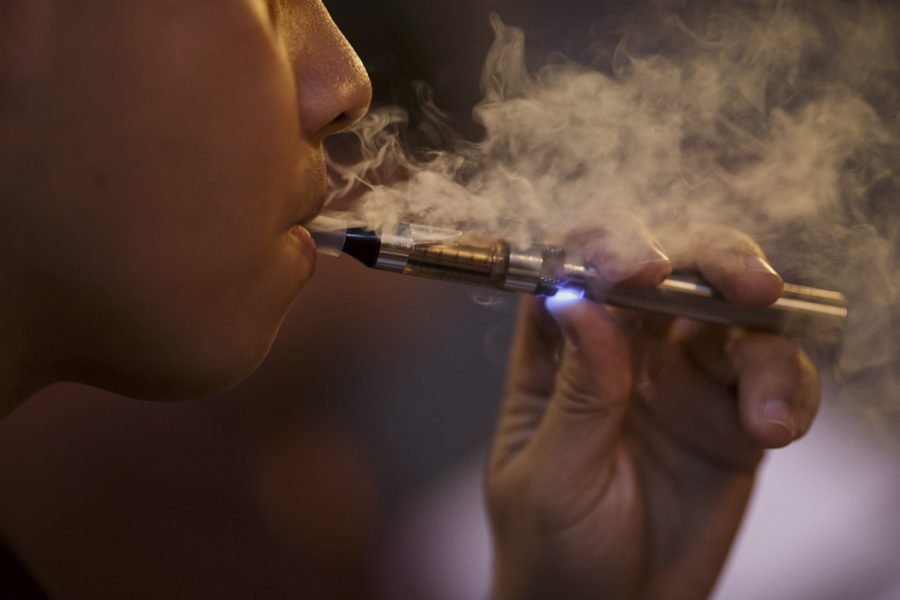Smoking cigarettes represented a large part of American culture for much of the 20th century — but now we know better.
As move into the depths of the 21st, and the harms of smoking become more difficult to ignore, a more modern form of smoking is taking over — the electronic cigarette. Just as Joe Camel is no longer an American icon, the glamour of e-cigarettes is diminishing as well.
The Health and Human Services Committee of the Allegheny County Council held a public meeting last Monday to hear input from community members about a potential vaping ban. The ban would prohibit vaping and the use of e-cigarettes in the same way it bans smoking and tobacco products, meaning not allowing the usage inside. The committee plans to take the more than 30 community members arguments for and against the ban into account and will deliberate at its next meeting whether to pass the bill on for consideration by the full council for its meeting March 1.
The bill should pass, and we should say goodbye to indoor vaping. Although e-cigarettes and vaping are often marketed as a safer alternative to traditional smoking, it’s not that simple. While a superior choice, vaping isn’t a healthy option by any means as it still poses many similar risks as cigarettes. The county council should move in favor of banning vaping and e-cigarettes in the same way as conventional smoking in order to prioritize health, especially for more vulnerable populations like our youth.
The county’s Board of Health first proposed the ban in November 2016, prohibiting its usage at schools, restaurants, enclosed businesses, transit stations, sports facilities and anywhere inside. Proponents of the ban claim that young people are easily attracted to the idea of e-cigarettes and that both vaping and exposure to secondhand vapors can have negative health benefits similar to cigarette smoke.
E-cigarettes were first invented in the 1960s but weren’t successfully manufactured and produced until 2003, meaning we’re still decades away from conclusive research about long-term effects. But researchers and scientists are already skeptical of the effects of e-cigs today. Since they heat liquid to create the vapor, e-cigs don’t expose users to the same toxins as traditional cigarettes, but the liquids burned can contain nicotine and other cancer-causing chemicals — such as anti-freeze and formaldehyde. And while secondhand vapor is less harmful than secondhand smoke, it can still expose others in the room to toxins. So banning vaping indoors should be an obvious move, even if it only reduces potential toxicity in a room by minimal amounts.
The allure and availability of e-cigarettes makes teenagers especially susceptible to getting hooked on vaping. The many options for flavors — bubble gum, coffee, dark chocolate raspberry — combined with the sleek and modern approach make e-cigs the perfect product to market to young people. While the number of middle and high school students who smoke went down from 2011 to 2015, the number of teens vaping increased dramatically, tripling from 660,000 in 2013 to 2 million in 2014, according to reports from the Center for Disease Control. The perpetuated idea that e-cigarettes are a healthier and cooler option than traditional smoking has no doubt contributed to the rise. Banning vaping the same way tobacco is banned would signal to students that e-cigarettes aren’t healthy, but are as potentially harmful as cigarettes.
Concerns among opponents of the ban suggest that if people who choose to vape as a method of quitting cigarettes are forced to do so in smoking-only zones, then the little incentive to use the healthier option is mostly taken away. If people have to go outside work, school or a restaurant to vape, they might as well just smoke. But a 2015 National Health Interview Survey found that 58.8 percent of the people who recently used e-cigarettes also smoked regular cigarettes. This means more than half of people using e-cigs don’t use them as a means to quit smoking anyway. And even if they are using vaping in order to quit, the short walk outside shouldn’t be enough to goad them into giving into temptation.
Voting for the ban would illustrate the council’s commitment to prioritizing health for its community and especially its youth — and would put it on par with the 500 other cities and 10 states that already banned vaping in public spaces. Even if it’s done merely preemptively, the ban will show that the county is looking out for the health of smokers and nonsmokers alike.
We get it, you vape — just please don’t make others susceptible to the fruit-scented smoke clouds while walking through public spaces.



